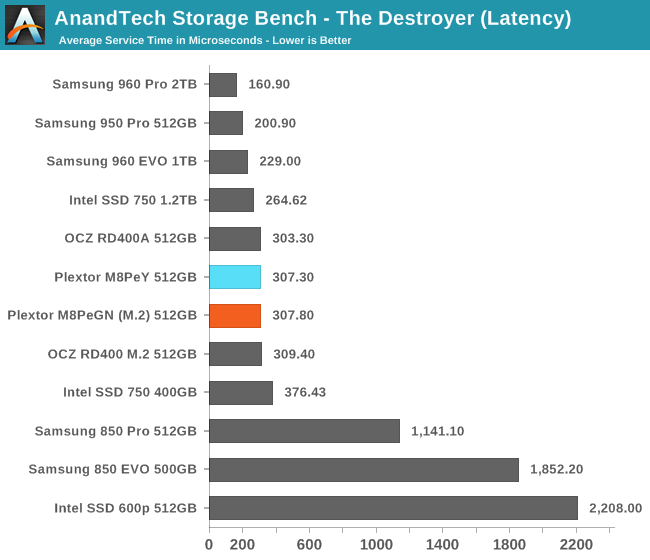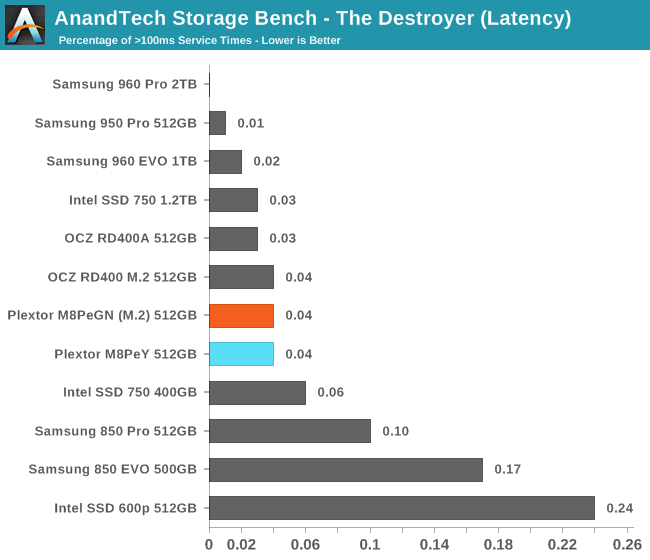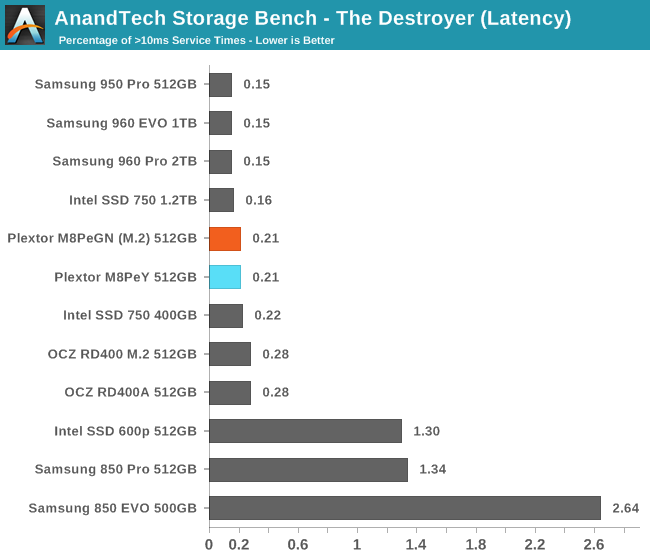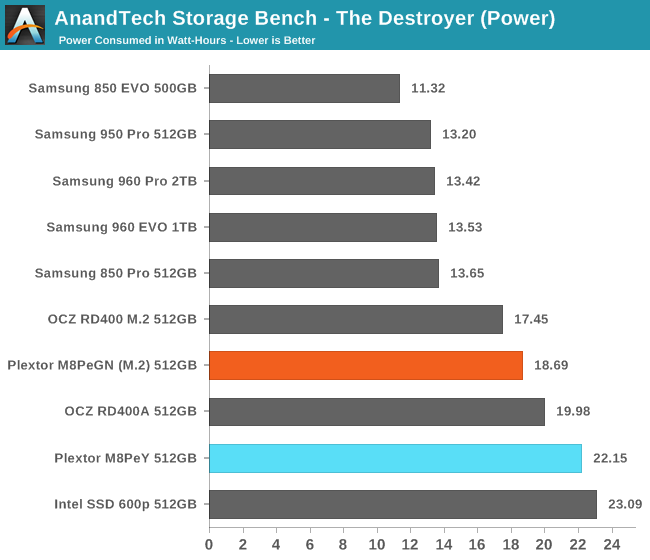The Plextor M8Pe (512GB) SSD Review
by Billy Tallis on December 14, 2016 9:00 AM ESTAnandTech Storage Bench - The Destroyer
The Destroyer is an extremely long test replicating the access patterns of very IO-intensive desktop usage. A detailed breakdown can be found in this article. Like real-world usage and unlike our Iometer tests, the drives do get the occasional break that allows for some background garbage collection and flushing caches, but those idle times are limited to 25ms so that it doesn't take all week to run the test.
We quantify performance on this test by reporting the drive's average data throughput, a few data points about its latency, and the total energy used by the drive over the course of the test.

The Plextor M8Pe isn't breaking any records on The Destroyer. Its average data rate is slower than Samsung's PCIe SSDs and the OCZ RD400, but it does beat the Intel SSD 750 and is about 75% faster overall than the fastest SATA SSDs. The heatsink on the M8PeY only provides a very slight performance boost.

The average service times of the M8Pe are on par with the OCZ RD400 and the Intel SSD 750, and substantially worse than Samsung's PCIe SSDs. The differences are minor in comparison to the huge latency advantage they all enjoy over the best SATA SSDs (and Intel's TLC-based SSD 600p).


The frequency of high-latency outliers places the M8Pe in the second tier of drives. Samsung's PCIe SSDs have few or no operations take more than 100ms and the smallest percentage of operations that exceed 10ms. The M8Pe scores similarly to the Intel SSD 750 and OCZ RD400.

The Intel SSD 600p is the only thing keeping the M8Pe from taking last place for power consumption among M.2 PCIe SSDs. The M8Pe uses significantly more power than the OCZ RD400, which itself is more power-hungry than Samsung's SSDs.










64 Comments
View All Comments
The_Assimilator - Wednesday, December 14, 2016 - link
Conclusion page: the paragraph "The performance differences between the Plextor M8Pe and the Toshiba OCZ RD400..." is repeated. BRO DO YOU EVEN EDITOR?Billy Tallis - Wednesday, December 14, 2016 - link
I think the problem may have been too much editor. My browser was getting really laggy and unresponsive while I was finishing up the article and rearranging things.Threnx - Friday, December 16, 2016 - link
Whoa there are still readers here? hah, I was cleaning out my bookmarks and saw anandtech. You realize all the talent left ages ago right? This site is dead. They're just riding on the name now...cbrownx88 - Friday, December 16, 2016 - link
@Threnx - where do you go now since Anandtech is a shell of its former glory?TemjinGold - Wednesday, December 14, 2016 - link
So... it basically loses across the board to the EVO but they want to charge more for it?Billy Tallis - Wednesday, December 14, 2016 - link
Keep in mind that the 960 EVO results here are for the 1TB model, and that kind of capacity advantage usually brings some performance advantage, too. But yeah, once the 960 EVO is actually shipping in volume, a lot of prices will probably have to come down. Unless the 960 EVO price goes up.close - Wednesday, December 14, 2016 - link
Prices for Samsung SSDs are rising due to the NAND shortage. If Plextor manages to resist this trend they might do well. After all most current workloads don't need anywhere near that kind of level of performance so a slight performance disadvantage is tolerable as long as it's reflected in the price.BrokenCrayons - Wednesday, December 14, 2016 - link
I wasn't aware of a NAND shortage. Do you happen to know the cause?Samus - Wednesday, December 14, 2016 - link
It's simply a supply and demand issue. Other causes are manufacturing process adjustments and lower yield issues often associated with transitioning to new processes.However, the shortage isn't as dire as 'close' makes it seem. Drive prices aren't necessarily increasing because of the shortage, but they aren't falling as they should be with the density improvements associated with TLC and widespread adoption of 3D VNAND. Samsung drives are increasing in price because vendors have noticed sharper demand for them than other drive, and I'm sure you can guess why based on this article alone...I'm not a Samsung fan, but they are currently the most balanced SSD products on the consumer market.
BrokenCrayons - Wednesday, December 14, 2016 - link
Ah that makes sense. Thanks!